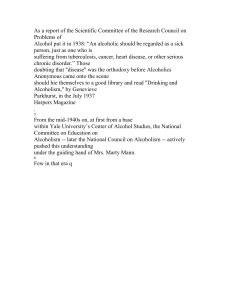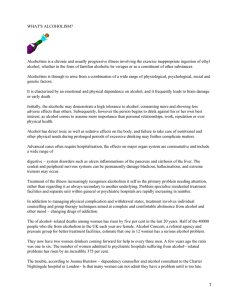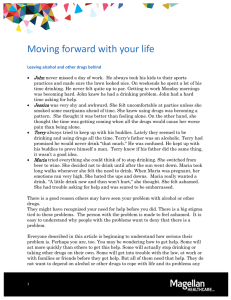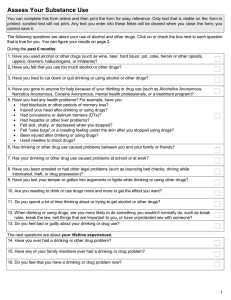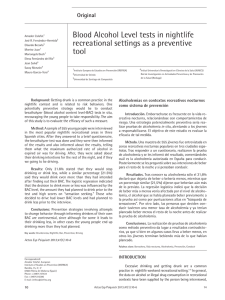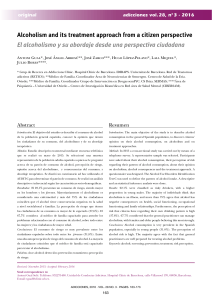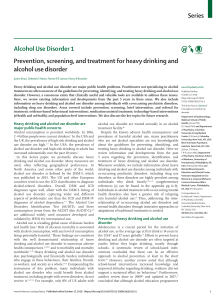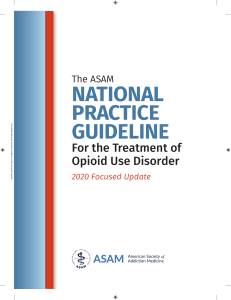The reduction of alcohol consumption. A new treatment
Anuncio
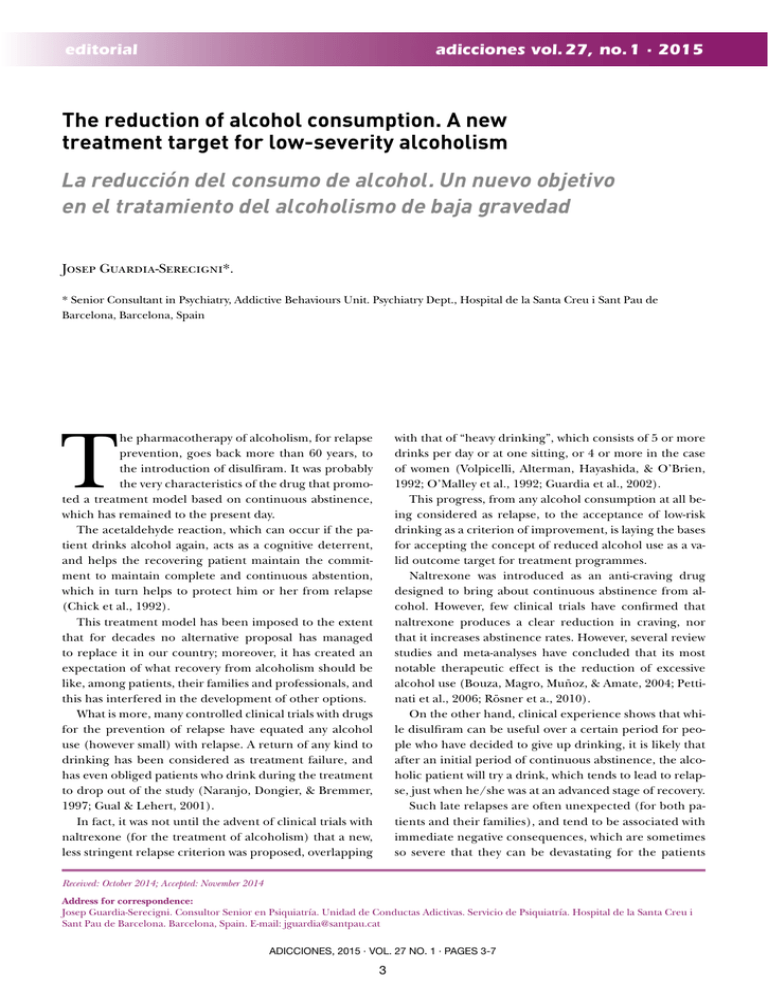
editorial adicciones vol. 27, no. 1 · 2015 The reduction of alcohol consumption. A new treatment target for low-severity alcoholism La reducción del consumo de alcohol. Un nuevo objetivo en el tratamiento del alcoholismo de baja gravedad Josep Guardia-Serecigni*. * Senior Consultant in Psychiatry, Addictive Behaviours Unit. Psychiatry Dept., Hospital de la Santa Creu i Sant Pau de Barcelona, Barcelona, Spain T he pharmacotherapy of alcoholism, for relapse prevention, goes back more than 60 years, to the introduction of disulfiram. It was probably the very characteristics of the drug that promoted a treatment model based on continuous abstinence, which has remained to the present day. The acetaldehyde reaction, which can occur if the patient drinks alcohol again, acts as a cognitive deterrent, and helps the recovering patient maintain the commitment to maintain complete and continuous abstention, which in turn helps to protect him or her from relapse (Chick et al., 1992). This treatment model has been imposed to the extent that for decades no alternative proposal has managed to replace it in our country; moreover, it has created an expectation of what recovery from alcoholism should be like, among patients, their families and professionals, and this has interfered in the development of other options. What is more, many controlled clinical trials with drugs for the prevention of relapse have equated any alcohol use (however small) with relapse. A return of any kind to drinking has been considered as treatment failure, and has even obliged patients who drink during the treatment to drop out of the study (Naranjo, Dongier, & Bremmer, 1997; Gual & Lehert, 2001). In fact, it was not until the advent of clinical trials with naltrexone (for the treatment of alcoholism) that a new, less stringent relapse criterion was proposed, overlapping with that of “heavy drinking”, which consists of 5 or more drinks per day or at one sitting, or 4 or more in the case of women (Volpicelli, Alterman, Hayashida, & O’Brien, 1992; O’Malley et al., 1992; Guardia et al., 2002). This progress, from any alcohol consumption at all being considered as relapse, to the acceptance of low-risk drinking as a criterion of improvement, is laying the bases for accepting the concept of reduced alcohol use as a valid outcome target for treatment programmes. Naltrexone was introduced as an anti-craving drug designed to bring about continuous abstinence from alcohol. However, few clinical trials have confirmed that naltrexone produces a clear reduction in craving, nor that it increases abstinence rates. However, several review studies and meta-analyses have concluded that its most notable therapeutic effect is the reduction of excessive alcohol use (Bouza, Magro, Muñoz, & Amate, 2004; Pettinati et al., 2006; Rösner et a., 2010). On the other hand, clinical experience shows that while disulfiram can be useful over a certain period for people who have decided to give up drinking, it is likely that after an initial period of continuous abstinence, the alcoholic patient will try a drink, which tends to lead to relapse, just when he/she was at an advanced stage of recovery. Such late relapses are often unexpected (for both patients and their families), and tend to be associated with immediate negative consequences, which are sometimes so severe that they can be devastating for the patients Received: October 2014; Accepted: November 2014 Address for correspondence: Josep Guardia-Serecigni. Consultor Senior en Psiquiatría. Unidad de Conductas Adictivas. Servicio de Psiquiatría. Hospital de la Santa Creu i Sant Pau de Barcelona. Barcelona, Spain. E-mail: [email protected] ADICCIONES, 2015 · VOL. 27 NO. 1 · PAGES 3-7 3 The reduction of alcohol consumption. A new treatment target for low-severity alcoholism mism tends also to affect family members, and even the professionals treating the problem. The reduction of alcohol use, with the help of nalmefene, is a new treatment target that brings clear advantages for low-severity alcoholic patients who follow closely the corresponding instructions. If a patient has begun to have “problems”, which are negative consequences of his or her excessive alcohol use, and the professionals treating the person help him/her to understand this relationship between such excessive consumption and those problems, it is likely that the patient will be well-disposed to reducing his/her intake. Patients often decide to stop drinking when they find themselves stressed by these “problems”. However, “stopping drinking” is not exactly the same as having the specific target of complete and continuous abstinence: patients tend to leave themselves the option of having the odd drink, in certain situations of celebration or when they meet up with friends and family, especially in their initial attempts to treat their alcoholism (Guardia-Serecigni, 2009; 2012). Lack of a proper understanding of the withdrawal effect and of the characteristics of the addictive disease lead patients, their families and their friends to think that control or lack of control over their drinking depends exclusively on their “willpower”, and they all tend to believe that if the patient were to just “try a bit harder”, he or she could manage to control it. Finally, when the patient manages to stay abstinent for a reasonable period of time, everyone thinks along the lines of “time is a great healer”, and that the patient will soon be able to have a few drinks without problems. This is the “trap” that usually leads to relapse, and only antagonists of the opioid receptors can protect the patient from a situation where that first drink indeed ends up leading to relapse. That is, the patient’s true objective is actually closer to a reduction in use than to continuous abstinence, since he or she tends to leave open the option of having a few drinks at some point in the future. If the patient has taken an opioid receptor antagonist, the day he or she takes a drink again, he/she can avoid relapse, and may succeed in being able to drink just occasionally and at low risk, which would signify clinical remission from alcoholism. However, when the patient seeks the euphoria-inducing effects of alcohol, or “needs” to drink so as to mitigate other psychiatric symptoms (anxiety, insomnia, depression, post-traumatic stress, etc.), reducing alcohol use may be more difficult, possible because this quest for the psychoactive effects of alcohol or the effect of self-medication may overpower the limited effect of opioid receptor antagonists. Indeed, clinical trials on treatment with naltrexone have only yielded small or moderate effect sizes (Feinn & Kranzler, 2005). themselves, since they lose confidence in themselves and in the treatment. If in addition to this the family shows rejection, the patient can develop self-destructive behaviours, which may even lead to suicide during relapse crises. In both studies with laboratory animals and in clinical practice it can be seen that when alcohol consumption is discontinued for a period, it is likely that intake increases considerably (due to loss of control) when the patient starts drinking again. This neurobiological phenomenon has been called alcohol deprivation effect, and is related to the functioning of the opioid system, since the administration of opioid receptor antagonists (such as naltrexone and nalmefene) can attenuate its impact (Kornet, Goosen, & Van Ree, 1990; O’Brien, Volpicelli, & Volpicelli, 1996; Sinclair, 2001). Treatment oriented towards continuous alcohol abstinence has several drawbacks. Probably the most important of these is the above-mentioned withdrawal effect (which begins on the day the patient starts drinking again); but there may be other, more subtle ones, which will interfere with both patients’ understanding and awareness of their addictive disease and the development of effective relapse-prevention strategies. Patients that are able to stop drinking altogether, for a while, have the illusory perception of being already fully “recovered”, because they no longer feel the “need” to drink and they have found it easy to stay abstinent. If moreover they take disulfiram or cyanamide, it is as though alcohol has ceased to exist, since it is no longer “available” to them. In such a situation, the patient does not drink at all and no longer craves for alcohol, and his or her behaviour has returned to normal. Such remission even leads patients to think that they didn’t really have an addictive disease, that maybe the doctor made a mistake in the diagnosis, or in any case, that they had an alcohol problem in the past, but that they’ve now “got over it”. From here on in they begin to think that at some time in the future they can have the odd drink without problems. Even their family and friends might begin to say that, since they have already gone so long without drinking, they have probably now recovered, and they could have a drink without it leading them to drink excessively (Guardia-Serecigni, 2008). Hence, conventional treatment with disulfiram or cyanamide does not favour understanding or awareness with regard to the underlying addictive disease, which tends to be persistent and can be reactivated by even just one drink, since the first glass can lead to uncontrolled drinking and relapse into heavy drinking, with all the associated negative consequences. Relapse will generate despair and pessimism, and can lead people to think (wrongly), that their alcohol problem has no solution. Such pessi- ADICCIONES, 2015 · VOL. 27 NO. 1 4 Josep Guardia-Serecigni much as possible, or even stop drinking altogether. They also learn that they have to protect themselves, taking a pill prior to their first drink after a period of abstinence, if they want to avoid the risk of losing control, of going back to excessive drinking, and of suffering the associated negative consequences. And the professional experts in alcoholism treating them can also play an important role, helping them to be aware of their addictive disease, and working with them on strategies for preventing a return to heavy drinking. Having reached this point, we can state that alcoholism corresponds to the medical model of illness, and can be treated like any other bodily dysfunction. The great difference is that the cardinal symptom, the “difficulty to control” alcohol intake, is not a bodily symptom but a behavioural one, but the similarity resides in the fact that it also responds to pharmacological treatment – that is, taking the medication at the right time has the effect of neutralizing the symptom and helps the patient to achieve the goal of reducing alcohol intake. Drawing a parallel with other diseases or bodily dysfunctions such as migraine crises, sea-sickness, insomnia, allergic rhinitis, or epigastric illnesses, we see that the therapeutic procedure normally consists in taking a pill (of the drug in question) at the moment the symptom appears, or even before it does (with the aim of preventing it), in situations in which it is likely that the symptom will reappear. This medical model involves the use of a treatment option “in case of need” or “on-demand”, which might be needed more frequently at first, but as the patient becomes more stabilized, the frequency will decrease, and it may become unnecessary at times. All the same, factors such as stress can contribute to a reappearance of the symptom, so that a further treatment episode is required, until stabilization is achieved once more, and eventually clinical remission. When the treatment targeting a reduction in alcohol use achieves the stabilization of the patient, or even, going a step further, when the patient finally stops drinking altogether, he or she will no longer need to take medication for a long time. However, it may be that the patient has another relapse at some later date; in that case, the medication will once again be necessary to avoid them falling back into heavy drinking. If patients manage to stay within the limits of low-risk drinking, on all occasions that they drink, they will also avoid the negative consequences associated with excessive alcohol intake. If the negative consequences disappear, we can consider that the patient is in clinical remission from alcoholism. And if the patient succeeds in maintaining this remission over a long period, in line with the aforementioned medical model of disease, we can consider that he or she has recovered from his/her illness. The efficacy of treatments targeting a reduction in alcohol use has been demonstrated only with nalmefene, in low-severity alcoholic patients (Van den Brink et al., 2013; Van den Brink et al., 2014). Future studies could broaden the severity spectrum of patients who might benefit from this new treatment objective. Low-severity alcoholic patients are those that do not present alcohol withdrawal effects, nor serious or decompensated medical, psychiatric or addictive comorbidities. The majority of alcoholic patients do not present withdrawal syndrome, but only difficulties for controlling their alcohol intake (which is what leads them to drink to excess), and nor do they present serious or decompensated comorbidities. Therefore, most people who suffer from this disease can be considered as low-severity, and can benefit from treatment with opioid receptor antagonists, targeting the ongoing reduction of their alcohol use – and this represents a paradigm shift in the treatment of low-severity alcoholism (Guardia-Serecigni, 2011). It is certainly the case that the majority of alcoholic patients are low-severity, given that just 20% present clear withdrawal syndrome (Anton, 2008). Patients with high levels of severity should begin their treatment with a detoxification programme, so as to alleviate the alcohol abstinence symptoms and facilitate their withdrawal from drinking. When alcoholic patients properly follow the instructions for reducing their drinking, at the same time as taking nalmefene (prior to having an alcoholic drink), the expected reduction effect appears right from the beginning of the treatment, and is maintained long-term, with the possibility, even, of achieving a gradual pharmacological extinction of the addictive behaviour. That is, if every time the patient ingests alcohol the expected reinforcing effect fails to occur, the quest for alcohol and its consumption lose relevance, the patient’s “obsession” to drink decreases, and his/her “freedom” to decide whether to have a drink or not increases, on each new potential drinking occasion that comes up. This “freedom” of decision with respect to alcohol may not seem very important to people who have never had difficulty controlling their drinking, but it is very important for those who have lost the ability to control their alcohol use. Moreover, greater awareness about addiction and lack of control over drinking may increase both the “obsession” to drink and the symptoms of grief, when one is obliged to stop drinking altogether, and this can lead to depression and increase vulnerability to relapse in some patients. In treatment with opioid receptor antagonists, alcoholic patients will follow a process in whose initial stages they still have the “need” or craving for a drink. This will help them to become aware of their addictive disease and also to realize that they should reduce their alcohol intake as ADICCIONES, 2015 · VOL. 27 NO. 1 5 The reduction of alcohol consumption. A new treatment target for low-severity alcoholism clinical trial. Alcoholism Clinical and Experimental Research, 26, 1381–1387. Guardia Serecigni, J. (2008). Alcoholismo. Guías Clínicas de Socidrogalcohol basadas en la Evidencia Científica. 2ª Edición. Barcelona: Socidrogalcohol. Guardia Serecigni, J. (2009). Avances en el tratamiento farmacológico del alcoholismo y de la enfermedad adictiva, una vez finalizado el tratamiento de la abstinencia aguda. JANO, 4, 21-33. Guardia Serecigni, J. (2011). Cambio de paradigma en el tratamiento del alcoholismo de baja gravedad. Adicciones, 23, 299-316. Guardia Serecigni, J. (2012). Tratamiento del Alcoholismo. En F. Pascual Pastor, & J. Guardia Serecigni (Eds.). Monografía sobre el Alcoholismo, pp. 415-442. Barcelona: Socidrogalcohol. Kornet, M., Goosen, C., & Van Ree, J. M. (1990). The effect of interrupted alcohol supply on spontaneous alcohol consumption by rhesus monkeys. Alcohol and Alcoholism, 25, 407-412. Naranjo, C. A., Dongier, M., & Bremner, K. E. (1997) Long-acting injectable bromocriptine does not reduce relapse in alcoholics. Addiction, 92, 969-978. O’Brien, C. P., Volpicelli, L. A., & Volpicelli, J. R. (1996). Naltrexone in the treatment of alcoholism: A clinical review. Alcohol, 13, 35-39. O’Malley, S. S., Jaffe, A., Chang, G., Schottenfeld, R. S., Meyerm R. E., & Rounsaville, B. (1992). Naltrexone and coping skills therapy for alcohol dependence a controlled study. Archives of General Psychiatry, 49, 881-887. Pettinati, H. M., O’Brien, C. P., Rabinowitz, A. R., Wortman, S. P., Oslin, D. W., Kampman, K. M., & Dackis, C. A. (2006). The status of naltrexone in the treatment of alcohol dependence: specific effects on heavy drinking. Journal of Clinical Psychopharmacology, 26, 610-625. Rösner, S., Hackl-Herrwerth, A., Leucht, S., Vecchi, S., Srisurapanont, M., & Soyka, M. (2010). Opioid antagonists dor alcohol dependence. Cochrane Database Systematic Review, 8, CD001867. doi: 10.1002/14651858.CD001867. pub2. Sinclair, J. D. (2001). Evidence about the use of naltrexone and for different ways of using it in the treatment of alcoholism. Alcohol and Alcoholism, 36, 2-10. Van den Brink, W., Aubin, H. J., Bladström, A., Torup, L., Gual, A., & Mann, K. (2013). Eficacia de nalmefeno administrado a demanda en pacientes con dependencia del alcohol con un nivel de consumo de riesgo como mínimo alto: resultados de un análisis de subgrupos de dos estudios controlados y aleatorizados a 6 meses. Alcohol and Alcoholism, 48, 570-578. Van den Brink, W., Sørensen, P., Torup, L., Mann, K., Gual, A., for the SENSE Study Group. (2014). Long-term efficacy, tolerability and safety of nalmefene as-needed in patients with alcohol dependence: A 1-year, randomised From that moment on, the patient can stop worrying about the episode of alcoholism, which he/she has now got over, and get on with resolving other more or less pressing problems. Conclusions Clinical trials on the treatment of alcoholism, with opioid receptor antagonists, have provided a new, less stringent relapse criterion, and have demonstrated their utility for the reduction of excessive alcohol intake. Nalmefene helps low-severity alcoholic patients seeking to reduce their alcohol use to achieve their goal. This new treatment approach brings recovery from alcoholism closer to the model of medical illness. If patients attain a significant reduction in their alcohol use, whereby they stay within the limits of low-risk drinking, on all occasions that they drink, this treatment can lead to clinical remission and also to the disappearance of the negative consequences of heavy drinking. Once remission has been achieved, the alcohol addiction ceases to be a source of preoccupation (for both patients and their families), and may well follow a course similar to that of medical disorders. Conflicts of interests The author participated as principal investigator in the ESENSE II study and has formed part of the Lundbeck España assessment committee on nalmefene. References Anton, R. F. (2008). Naltrexone for the management of alcohol dependence. The New England Journal of Medicine, 359, 715-721. Bouza, C., Magro, A., Muñoz, A., & Amate, J. M. (2004). Efficacy and safety of naltrexone and acamprosate in the treatment of alcohol dependence: a thematic review. Addiction, 99, 811-828. Chick, J., Gough, K., Falkowski, W., Kershaw, P., Hore, B., Metha, B., … Torley, D. (1992). Disulfiram treatment of alcoholism. British Journal of Psychiatry, 161, 84-89. Feinn, R., & Kranzler, H. R. (2005). Does effect size in naltrexone trials for alcohol dependence differ for single-site vs. multi-center studies? Alcoholism Clinical and Experimental Research, 29, 983-988. Gual, A., & Lehert, Ph. (2001). Acamprosate during and after acute alcohol withdrawal: a double–blind placebo-controlled study in Spain. Alcohol and Alcoholism, 36, 413-418. Guardia, J., Caso, C., Arias, F., Gual, A., Sanahuja, J., Ramírez, M., … Casas, M. (2002). A double-blind, placebo-controlled study of naltrexone in the treatment of alcohol-dependence disorder. Results from a multicenter ADICCIONES, 2015 · VOL. 27 NO. 1 6 Josep Guardia-Serecigni controlled study. Journal of Psychopharmacology, 28, 733744. doi: 10.1177/026988111452/362. Volpicelli, J. R., Alterman, A. I., Hayashida, M., & O’Brien, C. P. (1992). Naltrexone in the treatment of alcohol dependence. Archives of General Psychiatry, 49, 876-880. ADICCIONES, 2015 · VOL. 27 NO. 1 7
